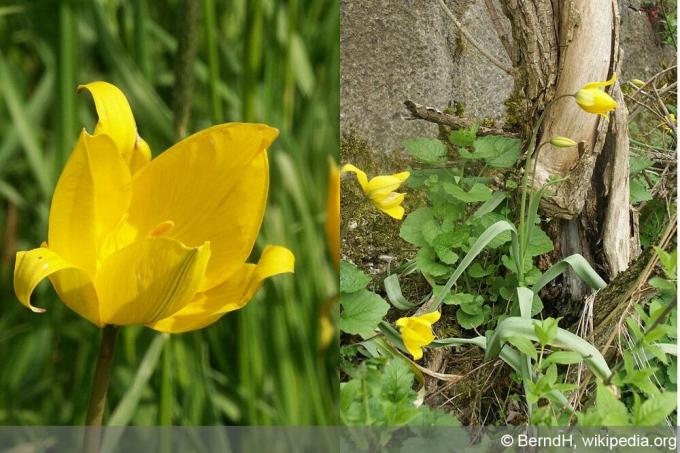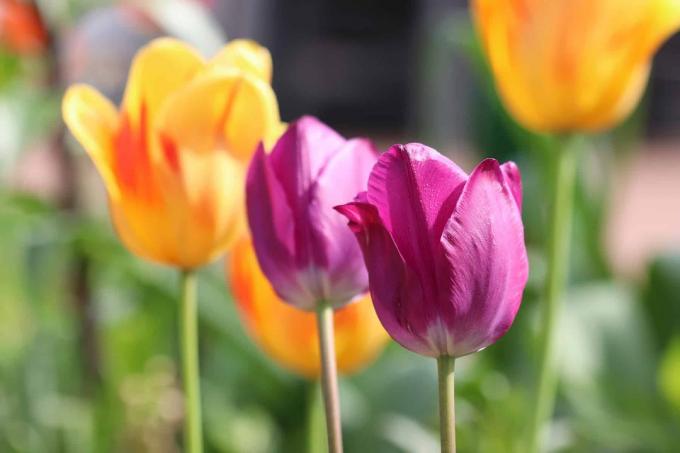

BerndH, Tulipa sylvestris 130405, edited by Hausgarten, CC BY-SA 3.0
Table of contents
- location and soil
- watering and fertilizing
- Cut
- multiply
- Vegetative propagation
- Generative propagation
- species
- Conclusion
The wild tulip is one of the most endangered species on the Red List. For decades it grew wild as a weed on vineyards, originally it comes from the Mediterranean and the Near East. With the professionalization, and above all with the use of herbicides in winegrowing, the Tulipa sylvestris have almost completely disappeared from our scene. That alone is reason enough to bring the pretty, yellow flowering lily plants into the gardens and to care for and propagate them there.
location and soil
As a heat-loving plant from southern Europe, it also prefers to grow in sunny and warm locations. However, they cope very well with cold winters and do not need any further winter protection. On the contrary, precautionary winter protection could result in too much moisture and parts of the plant would rot. Wild tulips are very sensitive to too much moisture when they are not in bloom. The soil should be loose and nutrient-rich. A pH between 8 and 10 is ideal. It is very sensitive to compacted soil, competition with lawns and the use of herbicides. That is ultimately also the reason why you hardly ever find them in the vineyards in Germany, at least on the conventionally cultivated areas. Their natural locations, such as sparse natural meadows in forests, are also becoming fewer and fewer.
watering and fertilizing
During the flowering period, the Tulipa sylvestris like it quite humid. During this time, especially when there is little rain, you should always keep the soil well moist. Then stop giving additional watering about 2-3 weeks after flowering. They prefer to spend the summer in the dry. If the location is ideal, the Tulipa sylvestris species actually require no horticultural care, and no fertilization either. In order to force the willingness to flower, the recommendation is sometimes made to fertilize them weekly during the flowering period. Everyone should trust their own experiences over time. In any case, no more fertilizer is applied after flowering.
Cut
The wild tulip does not need pruning. If you don't want to get seeds or want to avoid that it reproduces from its seeds, you can cut off the withered parts of the plant. At the same time, this ensures that the power now migrates to the next generation of bulbs, which will then produce many new flowers next year. The leaves remain on the plant until they are properly dry. Then they can be easily removed.
multiply
Tulipa sylvestris propagate generatively, by seed, and vegetatively, by bulbs. Therefore, if they like location and living conditions, they reproduce quite well. If it gets too much, you can dig out individual onions together with the onions in late summer to autumn. Now the onions can be removed and used elsewhere or given to the neighbors. The mother bulb can then be put back into the ground. Cutting back immediately after flowering prevents seeding.
Vegetative propagation
This is certainly the easiest way to increase the stock of Tulipa sylvestris and does not require any gardening activities. However, if you want to change the location because growth and propagation are to be desired at this point left over or simply to spread them further, one must be active in late summer to fall become. Each onion drives out at least one new daughter bulb per year on a runner, depending on the growth conditions several. The old bulb is initially exhausted and will not produce flowers in the next year. The onions are then separated from the mother onion and planted 10-15 cm deep in their new locations. It is best to place several onions in a well with the tip upwards. Then earth is put on top and the area is carefully trampled down. If large bulbs were present, they can flower as early as the following spring. In any case, a leaf should have formed.
Caution:
The bulbs of the wild tulip from the trade may not be planted in vineyards or in the wild. That would be an intervention in natural genetic diversity. Likewise, without the permission of the nature conservation authorities, you are not allowed to transplant onions from nature or from vineyards and certainly not to take them for your own garden.
Generative propagation
For a propagation in the garden, a conscious sowing is quite laborious. It can take five years until the first flowering. After flowering in spring, the ripe seeds form and can be collected. Before they sprout, the seeds need a cold stimulus from frost, which breaks their so-called dormancy. Due to humidity, warmth and longer days in spring, a sprout begins to grow downwards in order to form a bulb there. Towards the top you can initially only discover a grass-like stalk. A small, tulip-like leaf only becomes visible the following year. It can then take a good 3 years until the first flowering. Exposed outdoors, there is no need to worry about special winter protection, even in these early phases.
species
Bulbs from different wild species of tulips are available on the market, of which there are then several varieties. Thus, the colors and shapes of the individual wild species can vary greatly:
- Tulipa sylvestris – Wild Tulip, Vineyard Tulip, Forest Tulip: flowers yellow-greenish, growth height up to 35 cm
- Tulipa tarda – Star Tulip: flowers yellow and white; grows only 10 cm high; particularly suitable for rock gardens; very prolific
- Tulipa bifloriformis – Tashkent Tulip: flowers snow-white and yellow, mostly three flowers on short peduncles; Growth height up to 30 cm
- Tulipa humilis – dwarf tulip: white flowers with a blue-violet heart, red and violet flowering varieties are also available; growth height approx. 15 cm
- Tulipa clusiana– Lady Tulip: flowers yellow with elegant, lanceolate petals; 1-2 flowers per plant; Growth height up to 30 cm
Conclusion
Wild tulips planted in groups are a wonderful eye-catcher in rock gardens or in natural, sunny beds. The star-shaped flowers are fragrant in the sun and attract particularly small wild bees. In damp weather and at night, the flowers close. Those who have found the right location for the Tulipa sylvestris can enjoy these robust and charming tulips for years.
 garden editorial
garden editorial I write about everything that interests me in my garden.
Learn more about flower bulbs

Tulips do not bloom and only put out leaves: what to do?
Tulips are among the most popular spring bloomers. They are therefore extremely common in domestic gardens. However, various causes can lead to the onion plants only developing leaves and no flowers. You can find out what to do in this case here.

Madonna lily, Lilium candidum: 9 care tips
Due to its growth height of more than one meter and the imposing white funnel-shaped flowers, the Madonna lily is one of the most impressive native bulbous plants. What to look out for when caring for this impressive flower is summarized in 9 clear care tips.

Daylilies, Hemerocallis: care from A – Z
Daylilies (Hemerocallis) are among the loveliest and most rewarding flowering perennials. Even if each individual blossom lasts only one day, countless new blossoms form again and again and decorate the garden for weeks. In addition, they are available in almost every color imaginable.

Freesia, Freesia: care tips from A - Z
Freesias are popular summer plants because they are colorful and have a pleasant, delicate scent. The irises, originally from Africa, are not difficult to care for, but do not tolerate frost. You can easily propagate the freesias yourself using the bulbs.

Milk Star, Ornithogalum: care from A to Z
The Orange Milk Star (Ornithogalum dubium) is a popular ornamental plant from the Cape Province. Because of its decorative flowers, it is often used as a cut flower in flower arrangements. The ornamental plants are undemanding, but should be cared for with caution due to their toxicity.

Checkered flower: care from A to Z | Instructions
The checkered flower (Fritillaria meleagris) attracts everyone's attention with its bell-shaped flowers. The reason for this is their striking pattern, which is strongly reminiscent of a chessboard. This striking check pattern shows the bulb flower in different shades.
